The Works of George A. Barton (15 vols.)
Digital Logos Edition
Overview
The Works of George A. Barton cover a wide array of subjects: biblical studies, world religions, linguistics, archaeology, and more. Barton sought to make ancient Near East studies accessible to the pastor and Sunday school teacher, and his research and academic work continues to be recognized for its importance to this day. The 15 volumes in this collection include:
- Jesus of Nazareth: A Biography—Barton's popular work on the life of Jesus
- The Religion of Israel—Barton's study traces the development of Israel's religion from its primitive Semitic beginnings to the coming of Christ
- The Roots of Christian Teaching as Found in the Old Testament—Barton mines the people and stories of the Old Testament for timeless Christian truths
- A Year's Wandering in Bible Lands—In this 1902 travelogue, Barton connects the people and events of Bible history with photos from his journey, giving a unique look at the Bible lands at the turn of the twentieth century
- Plus 11 more books that explore the Christian message, biblical archeology, Barton's translations of hundreds of cuneiform tablets, and much more!
With the Logos Bible Software edition all Scripture passages in The Works of George A. Barton (15 vols.) are tagged and appear on mouse-over. This makes these resources more powerful and easier to access than ever before for scholarly work or personal Bible study. With the advanced search features of Logos Bible Software, you can perform powerful searches by topic or Scripture reference—finding, for example, every mention of "resurrection" or "Isaiah 53:11."

Key Features
- Contains George A. Barton's most popular works, including Jesus of Nazareth: A Biography
- English translations of many ancient texts that shed light on Scripture
- Detailed discussions of the cultures and civilizations relevant to the Bible
Product Details
- Title: The Works of George A. Barton
- Author: George A. Barton
- Volumes: 15
- Pages: 3,446
Individual Titles
- Jesus of Nazareth: A Biography
- The Heart of the Christian Message
- A Year's Wandering in Bible Lands
- The Religions of the World
- The Religion of Israel
- A Sketch of Semitic Origins: Social and Religious
- Sumerian Business and Administrative Documents from the Earliest Times to the Dynasty of Agade
- Miscellaneous Babylonian Inscriptions
- The Roots of Christian Teaching as Found in the Old Testament
- Semitic and Hamitic Origins: Social and Religious
- New Babylonian Material Concerning Creation and Paradise
- Haverford Library Collection of Cuneiform Tablets or Documents from the Temple Archives of Telloh, vol. 1
- Haverford Library Collection of Cuneiform Tablets or Documents from the Temple Archives of Telloh, vol. 2
- Haverford Library Collection of Cuneiform Tablets or Documents from the Temple Archives of Telloh, vol. 3
- Oriental Studies
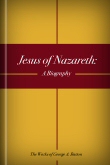
The life of Jesus Christ is the most important event in the religious history of mankind. The significance of it is eternal. Nowhere else has God so revealed his nature. How should one approach the task of writing an account of it? George A. Barton belongs to the historical school, and seeks to use the knowledge of the composition and dates of the Gospels which has been gained through modern study in accordance with the methods of modern historical research. He divides Jesus of Nazareth: A Biography into six parts:
- Things to Be Known Beforehand
- The Life of Jesus before His Ministry
- The Ministry of Jesus in Galilee
- The Peræn Ministry of Jesus
- Jesus Avoiding His Enemies
- The Passion and Resurrection

The lectures contained in The Heart of the Christian Message were delivered to the Society of Friends of Massachusetts, and then a portion of them were published as a series in the Friends' Quarterly Examiner. George A. Barton then revised them for publication in book-form. The lectures trace the growth of Christian doctrine and polity. Included are:
- The Message of Christ
- The Christian Message According to Paul
- The Christian Message in the Johannine Writings
- The Christian Message in the Eastern Church
- The Christian Message in the Western Church
- The Christian Message According to the Reformers
- The Christian Message According to the Early Friends
- The Christian Message for the Twentieth Century
It is a valuable little book for one who wishes to study the forest of Christian thought without getting lost among the trees of histories of doctrines.
—Biblical World
It would be hard to find a more impartial and just estimate of the Quaker movement, inaugurated by George Fox, and the Christian message according to the early Friends than that which Professor Barton has given us in the seventh chapter.
—Springfield Republican
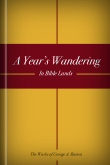
A Year's Wandering in Bible Lands is George A. Barton's memoir of traveling through the Bible lands during the year 1902. Accompanying his travelogue is over 100 black and white photographs of the people and places he encountered while traveling on horseback. Reading A Year's Wandering is like visiting the Holy Land with Dr. Barton as a guide, and at each place hearing his account and explanations of its connection with the men and events of Bible history.
To the Bible reader and the one who is acquainted with the ancient history the photographs will be especially suggestive.
—The American Antiquarian and Oriental Journal
To visit such scenes under such guidance gives new understanding of the Bible.
—Friends Intelligencer
Its fine and numerous illustrations give it special value as a pictorial companion book to the Bible.
—Outlook
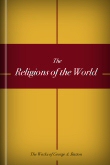
Designed as a college textbook, George A. Barton presents a broad survey of world religions. Studies on the religions of Babylonia and Assyria, the Ancient Hebrews, Judaism, Islam, Zoroastrianism, the religion of the Vedas, Buddhism and Jainism, Hinduism, and more, are included. A great reference for quickly grasping the major tenets of the world's religions throughout history, this volume also includes Barton's essay "The Unfolding of the Idea of God in the Religions of the World."
A terse, well-written textbook packed with the facts concerning the great religions of the world.
—American Review of Reviews
The work is distinguished by its emphasis of essentials, its untechnical descriptions, and its comprehensiveness.
—Nation
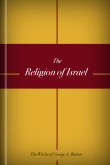
In The Religion of Israel, George A. Barton presents the development of Israel's religion from its primitive Semitic beginnings to the coming of Christ. Barton also explores the development of the priesthood, and the belief in angels and demons.
Dr. Barton, to whom the immensely important but correspondingly difficult subject of the Religion of Israel has been entrusted, is one of the most accomplished and productive of our American Orientalists and Semitic scholars. In the present volume Dr. Barton will sustain his reputation for the thoroughness of his scholarship and the mastery of his field.
—Harvard Theological Review
The book is exceedingly well written, most happily arranged, and will not soon be superseded in its field.
—Unitarian Register
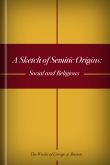
Dr. Barton vividly traces the course of Semitic evolution through the weary centuries which led from primitiveness to civilization. The book contains much valuable information in regard to the sociological literature and theories of the times, and is altogether an important and scholarly contribution to our knowledge of those vague periods.
Suffice it to say that Professor Barton has brought to his task such a wealth of knowledge and a power of arranging his facts and drawing his deductions as must make his book a work to be reckoned with by any future student of primitive Semitic religion.
—Church Quarterly Review
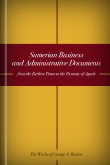
The 132 tablets pictured in this volume are from the time of the dynasty of Agade and earlier periods. They mostly consist of the payrolls, contracts, receipts, etc., which reflect the economic life of ancient Babylonia. One group contains a series of transactions of Nippur merchants. George A. Barton provides gives a translation of six of the tablets, a list of the proper names in the collection, autographs of all the tablets, and 18 photographic views.
It is apparent that Professor Barton ranks very high as an interpreter of archaic and cuneiform Babylonian texts. He has a thorough knowledge of the signs and is an ingenious translator, who in his presentation of autograph texts in this volume has certainly made a valuable contribution to our knowledge of the Ancient Babylonian world of affairs.
—The American Journal of Semitic Languages and Literatures
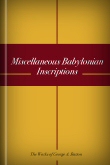
In this volume there are published 12 religious texts belonging to the Museum of the University of Pennsylvania. Photographs of some of the inscriptions are included, together with Barton's copies, transliteration, translation, and discussion of them.
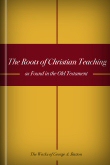
In the following pages the reader will find brief sketches of Old Testament ideas and institutions, mingled with character studies of Old Testament heroes. In each case the Christian truth, of which the sketch presents a type or parable, is briefly set forth in such a way that a reader may enjoy its religious significance.
In such helpful fashion the book deals with the problems of sin and suffering, with the Christ and his message, with sacrifice and its meaning. So also he sketches the lessons to be found in the lives of the patriarchs, of the judges, of the prophets. Altogether it may safely be said that no more helpful book for directing the devotional use of the Old Testament is to be found among the publications of many years.
—Friends Intelligencer
In 57 short chapters the author treats of such subjects as the unity of God, sin as transgression, the temple of the heart, the passage of the Red Sea, and the leading figures of the Old Testament. His meditations are intelligent in interpretation and insight, devout in tone, and helpful in teaching and spirit.
—Presbyterian Banner
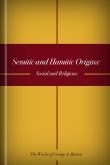
Semitic and Hamitic Origins: Social and Religious is a revision of A Sketch of Semitic Origins: Social and Religious. After 30 more years of continuous research, Barton has revised his previous theories and put together the results in this newer work.
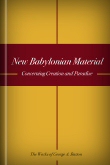
This essay on Babylonian creation stories first appeared in The American Journal of Theology in 1917.
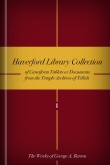
The 117 texts presented in this volume were the first of the Haverford Library Collection of cuneiform tablets to be published. The whole class of tablets, some 400 of them, are of a business and administrative character, and shed light on the economic environment of an ancient people such as can be made of no other people of antiquity known to us.
Professor Barton's work is an important contribution to the reconstruction of the Babylonian system of writing mathematical terms. Beside the points of historical value, he has determined other facts such as the price of wheat in the pre-Abrahamic age. This work, also, is an important contribution to sumeriology.
—Records of the Past Exploration Society
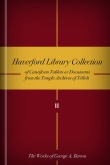
The 94 texts presented in this volume were the first of the Haverford Library Collection of cuneiform tablets to be published. The whole class of tablets, some 400 of them, are of a business and administrative character, and shed light on the economic environment of an ancient people such as can be made of no other people of antiquity known to us.

The 184 texts presented in this volume were the first of the Haverford Library Collection of cuneiform tablets to be published. The whole class of tablets, some 400 of them, are of a business and administrative character, and shed light on the economic environment of an ancient people such as can be made of no other people of antiquity known to us.

Oriental Studies contains a selection of papers read before the Oriental Club of Philadelphia between the years 1888–1894. Along with George A. Barton's "Native Israelitish Deities," this volume includes "Who Were the Ancient Ethiopians," by W. Max Müller, "A Legal Document of Babylonia," by Morris Jastrow, and 11 more addresses.
About George A. Barton
George Aaron Barton (1859–1942) taught at Haverford College, Bryn Mawr, and the University of Pennsylvania where he was Professor of Semitic Languages from 1922–1931 and Professor Emeritus from 1932–1942. His many articles and books cover a wide range of topics in areas such as biblical studies, religion, and linguistics. He was also involved in archaeological projects throughout the Middle East and was the director of the American School of Oriental Research in Baghdad from 1921–1934. He was the first to translate the set of Sumerian tablets recovered in the 1896–1898 excavation of Nippur.
Don't miss out on these other important works by George A. Barton: Archaeology and the Bible, A Critical and Exegetical Commentary on the Book of Ecclesiastes, and The Book of Job.
Reviews
4 ratings
Dave St. Hilaire
7/29/2015

William L White
12/4/2013

Larry Proffitt (I
11/5/2013

Jerry Peterson
8/15/2013